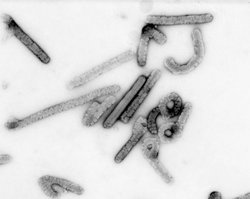Marburg fever
The Marburg virus is the causative agent of Marburg hemorrhagic fever. Both the disease and virus are related to Ebola and originate in the same part of Africa (Uganda and Eastern Congo). The zoonosis is of unknown origin, but some scientists believe it may be hosted by bats. more...
The disease is spread through bodily fluids, including blood, excrement, saliva, and vomit. There is no cure or vaccine for this deadly and infectious virus. Victims suffer a high fever, diarrhea, vomiting, and severe bleeding from bodily orifices and usually die within a week. Fatality rates range from 25 to 100 %.
In the spring of 2005, the virus attracted widespread press attention for an outbreak in Angola. Beginning in October 2004 and continuing into 2005, the outbreak, which is now thought to be under control, was the world's worst epidemic of any kind of hemorrhagic fever.
The Marburg virus
The viral structure is typical of filoviruses, with long threadlike particles which have a consistent diameter but vary greatly in length from an average of 800 nanometres up to 14,000 nm, with peak infectious activity at about 790 nm. Virions (viral particles) contain seven known structural proteins. While nearly identical to Ebola virus in structure, Marburg virus is antigenically distinct from Ebola virus — in other words, it triggers different antibodies in infected organisms. It was the first filovirus to be identified.
Infection details
Because many of the signs and symptoms of Marburg hemorrhagic fever are similar to those of other infectious diseases, such as malaria or typhoid, diagnosis of the disease can be difficult, especially if only a single case is involved.
The disease is characterised by the sudden onset of fever, headache, and muscle pain after an incubation period of 3-9 days. Within a week, a maculopapular rash develops, followed by vomiting, chest and abdominal pain, and diarrhea. The disease can then become increasingly damaging, causing jaundice, delirium, organ failure, and extensive hemorrhage. Patients generally die from hypovolemic shock as fluid leaks out of the blood vessels, causing blood pressure to drop.
Recovery from the disease is prolonged and can be marked by orchitis, recurrent hepatitis, transverse myelitis or uveitis, or inflammation of the spinal cord, eyes, or parotid gland. Depending upon health care and hospitalization support, the disease can have very high fatality rates, with estimates ranging from 25 % up to 100 %.
Infection is believed to be spread by close contact with body fluids of those infected, and the virus is unlikely to spread through casual contact. Patients are most contagious during the acute phase of the illness when fluids such as vomit and blood are present. Unsafe burial practices such as embracing, kissing or ritual bathing of the corpse present another infection vector.
According to a report in the New York Times, the virus moves very quickly. "On Day 3 of the infection, fewer than 200 viruses are in a drop of blood. By Day 8, there are five million."
Read more at Wikipedia.org



